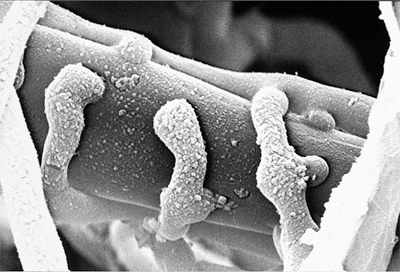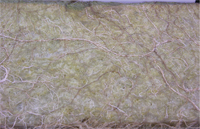
Damping-off and root rot caused by Pythium spp. (species) is one of the most commonly occurring diseases in greenhouse crops. Most Pythium
spp. principally infect young, succulent tissues and therefore
infection is usually restricted to feeder roots or root tips of older
plants.
These products are protective and suppressive; they are not curative and should be applied preventively
 |
|
| Photograph taken with scanning electron microscope shows the finer fungal strands of Gliocladium catenulatum (active in Prestop®) attaching to fungal strand of Rhizoctonia solani to parasitize it. Photo provided with the kind courtesy of Verdera. Advertisement
|
Damping-off and root rot caused by Pythium spp. (species) is one of the most commonly occurring diseases in greenhouse crops. Most Pythium spp. principally infect young, succulent tissues and therefore infection is usually restricted to feeder roots or root tips of older plants. Pythium survives best when other micro-organisms are either not present or have reduced activity such as in virgin rockwool or other soilless media.
Pythium spp. can survive by growing saprophytically on dead tissue, or by zoospores (tiny swimming structures) that can persist at least seven days in moist media, by means called sporangia, which can survive for several weeks, or by thick-walled oospores that can remain live for up to several years.
To infect plants, Pythium must germinate and it does so in response to seed or root exudates (amino acids, sugars, other compounds). The most important factors for infection are temperature and moisture of the media.
HIGH MOISTURE OFTEN A FACTOR IN DISEASE DEVELOPMENT
■ Generally, high moisture is necessary for disease development. Optimum temperature requirements vary depending on species. For example, P. aphanidermatum, which commonly occurs in greenhouse vegetable crops, particularly cucumbers, is more damaging at higher temperatures. Another important species is P. dissocotum, which can cause disease at lower temperatures. Other factors conducive to disease, more likely through their effects on the host plants, include low ECs, pH, unbalanced nutrition, low light intensity and reduced oxygen availability.

|
|
| Roots of greenhouse tomato infected with Pythium sp. in rockwool slab. |
Pythium infects roots rapidly, and because the activity of biological control agents is suppressive, they must be used preventively. Microbial biological control agents work in several ways against pathogens, including competition and parasitism. Commercially produced microbial biological control agents available for use in greenhouse vegetables for suppression of Pythium spp. include, in alphabetical order, Mycostop®, Prestop®, and RootShield®.
Mycostop – The active ingredient in this product is a bacterium called Streptomyces griseoviridis. This bacterium is active between 15ºC and 30ºC, and it works over a wide range of pH (5.0-8.5). It becomes inactive at temperatures above 45ºC and below 5ºC.
Streptomyces griseoviridis does not use live plant cells for nutrition and so does no harm to the plant; however, it requires their presence to actively grow and control fungal pathogens. It only grows slowly in the absence of living roots. This microbial grows on the root surface and uses root exudates and dead cells as an organic nutrient source.
The antagonistic effect of S. griseoviridis is based on several mechanisms: e.g., on competition with the pathogen for nutrients, and on parasitism by producing enzymes that break down the cell walls of the pathogen. It particularly seems to favour root exudates of cucumber. In addition to Pythium, S. griseoviridis also targets Fusarium, Phytophthora and other disease-causing pathogens.
Prestop – The active ingredient in Prestop is a fungus, Gliocladium catenulatum strain J1446. Gliocladium catenulatum suppresses other fungal pathogens by two main mechanisms, competition and parasitism.
Gliocladium catenulatum competes with other fungi for nutrients and living space, thereby preventing them from successfully establishing on the plant. It is also able to parasitize competing fungi, resulting in breakdown of their cell walls.
Work done at Simon Fraser University by Punja and Yip with this microbial against Pythium on cucumbers resulted in very good suppression when the product was applied twice and preventively to seedlings. Such results were obtained despite relatively high Pythium pressure. It also suppresses Fusarium and Phytophthora.
RootShield – The active ingredient in RootShield is a fungus, Trichoderma harzianum strain T-22. Trichoderma harzianum becomes active when soil temperatures are above 10ºC. Control is not effective while soils remain cold and is more effective in neutral or acidic media than in alkaline media (>pH 8.5). However, it does not persist at biologically significant levels in the absence of roots, except in highly organic soils. Trichoderma harzianum suppresses pathogenic fungi by parasitizing them. It is able to coil around the pathogenic fungus and produce enzymes that dissolve the cell walls. Microscopic observation of T. harzianum indicates that it colonizes the entire root and is extremely persistent on root surfaces. In addition, T. harzianum produces other compounds that act against the pathogen.
As with the other two biocontrol agents, T. harzianum competes with pathogens for space and nutrients. Field trials with T. harzianum at the University of Florida resulted in reduction of Fusarium crown and root rot in tomato.
It must be emphasized that these products are protective and suppressive in nature. They are not curative and should be applied preventively. All of the above products are compatible with the fungicides, Previcur® and Ridomil®, but they are best applied in separate tanks. If such biocontrol agents are used as recommended, and in combination with other strategies that minimize conditions favourable to Pythium growers will be able to successfully suppress incidence of Pythium root rot.
Acknowledgment: Review of this article by John Francis of Bioworks Inc. and Marja-Leena Lahdenperä of Verdera is gratefully acknowledged. ■
Gillian Ferguson is the greenhouse vegetable IPM specialist with the Ontario Ministry of Agriculture, Food and Rural Affairs in Harrow.
• 519-738-1258, or gillian.ferguson@ontario.ca
Print this page